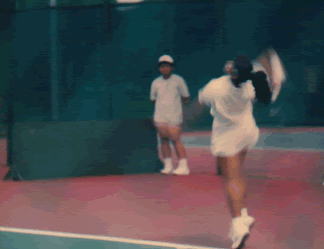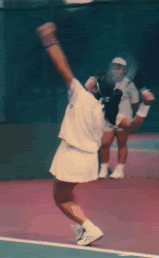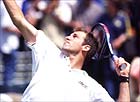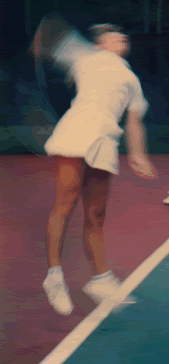
|
||||||
|
Winning Fundamentals |
|
Essential Skills The proper ways of hitting a tennis ball must be learned on the court, but the basic skills are briefly described here. In order to play a game of tennis, a student must be able to serve, to hit the ball when it bounces (hit ground strokes), and hit the ball before it bounces (punch a volley). Tennis players must learn to hit the ball when it is approaching on their left and on their right sides.For a right-handed player, shots made on the right are called forehand shots; those made on the left are called backhand shots. The forehand and backhand sides are reversed for a left-handed player, of course. The first principle of tennis is this: Keep your eye on the ball at all times it is in play. Many players tend to look away from the ball just as it contacts the racket; that is a mistake that frequently causes an otherwise good shot to go far wide of where it should have gone. Sometimes a player looks away from the ball to see where the opponent is moving. That practice is bound to produce mistakes in hitting the ball, and thus it will not matter where the opponent has moved. A second principle of tennis is that all shots should be made with the body weight or momentum moving into the shots. Never allow the weight to be on the back foot going away from the shot. Footwork:
Correct footwork in the game of tennis can be the difference between a
win or a loss. If your footwork is lazy you will loose several point from footwork alone.
Poor footwork can effect all aspects of your game forcing you to over compensate
in the other parts of your game. Of all the areas of tennis, footwork is the most important to be naturally flowing without
ever having to think about it.
Slow and lazy footwork will not allow you to defend your court, and be
the result of poor defense. If you cannot move to the ball you cannot be a good defensive player, plain and simple.
Luckily you do not have to be fast to be effective. Proper footwork can
keep you in the game and always a step ahead...more....
When a tennis ball is allowed to bounce prior to being hit, the shot is called a ground stroke. For almost all players, ground strokes are the most commonly hit shots -- thus, it is obvious that the skills of hitting ground strokes should be learned and practiced well. Ground strokes are most frequently made near or behind the baseline. As soon as the player can determine on which side (left or right) a bouncing ball should be hit, the player should prepare to turn to that side. Ground strokes should be hit by first turning sideways to face the path of the ball. Racket preparation is extremely important in hitting ground strokes; in order to hit them correctly, the racket should be taken back until it almost points to the fence at the back of the court. Then the racket is swung forward, contact is made with the ball about even with the front hip, and the racket continues to follow through in front of the player. The word "stroke" in "ground stroke" is significant. The ball is not punched or slapped, it is stroked across the court with a long, continuous racket movement. Volley When a ball is hit in the air prior to bouncing, the shot is called a volley. A volley is a very different shot from the ground stroke. A classic volley is punched, with a crisp short movement of the racket with little back swing. The player hitting a classic volley keeps the racket in front of the body and punches directly toward the spot on the opponent's court that the ball will hit. Volleys are usually made near the net. A good rule to follow is that the amount of back swing for a classic volley should be directly related to the player's distance from the net: close to the net there is little back swing; at mid-court there is slightly more back swing, and at the baseline there is moderate back swing. Recently, some players have been hitting swinging volleys. These are usually tournament-level players who prefer to hit ground strokes near the base line. As its name suggests, the swinging volley has much more back swing than a classic volley -- and the additional swing and increased racket speed results in a volley hit with more pace. For most players, a swinging volley is extremely difficult to execute, and, thus, it is a low-percentage shot. Since a well-placed crisply punched volley is almost always an outright winner, the only reason to attempt a low-percentage swinging volley is to try to overwhelm the opponent. Volleying is an important skill in both doubles and singles. In doubles, one player on each team almost always starts the point standing near the net, and thus that player will hit few shots except volleys. In singles, it is possible to learn to play a style of tennis that requires you to make few volleys in a match. Nevertheless, volleying must be mastered, since if opponents suspect that you are unable to volley, they will hit short shots that pull you to the net where you must volley. Serve In singles, one player serves all of the points until a game is over. Then the player who has been receiving, serves the second game. The players alternate serving games until the end of the match. Serving is slightly more complex in doubles. At the start of a match, one team selects a server for the first game of the set, then the other team selects a server for the second game. The third game is served by the partner of the server of the first game, and the fourth game is served by the partner of the server of the second game. The players continue to alternate serving in the same way until the end of the set. At the start of a second or later set, the team that just received serve will serve the first game of the new set. Either member of that team may serve to start the new set. After the four players have served the first four games in the set, they continue to serve in the same order until the end of the set. Each point starts with one of the players serving the ball into a service court diagonally opposite. The first serve of a game is made by a player standing outside the court, behind the baseline and between the center mark and the sideline to the server's right; the serve for the first point must bounce in the deuce service court on the opposite side of the court. The next point is served from behind the baseline between the center mark and the sideline to the server's left into the ad service court on the opposite side of the court. Once upon a time in the history of tennis, points were started by one player tossing the ball in the air at about waist height, and gently hitting the ball with an underhand racket motion. In more recent times, it was discovered that the way the ball was put into play at the start of the point could be an immense advantage to the server. Modern players serve the ball by tossing it well overhead, and making contact with it as high in the air as possible. Learning to serve well is not easy, but since players can be sure of no worse than a tie if they can win the points that they serve, it is important to have an effective serve. Moreover, unlike other shots, since serving can be practiced alone on a court with a bucket of balls, there is no good excuse for not learning to serve well. The
server can make two attempts to put the ball in play in the diagonally opposite service court.
If
the first serve of a point lands outside the proper service court, the server may make a second serve.
If
the second serve also lands outside the court, the receiver wins that point.
A
serve that touches the net on its way over and then lands in the proper court is said to be a "let" serve, and the server
does it again (regardless of whether it is the first or second serve).
Any time a ball bounces on a line (whether it is a serve or any other shot), it is
considered to be in the court; it is a good shot, and it must be played.
|
|
|





